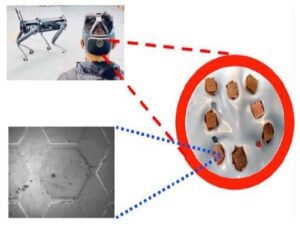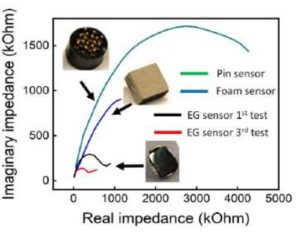
Prof. Francesca Iacopi, Scientific Associate Investigator – ARC Centre of Excellence in Future Low-Energy Electronics Technologies, University of Technology Sydney
The Challenge
Deploying a high-efficiency, non-invasive Brain Computer Interface (BCI) system for hands free control of electronic devices, cognitive monitoring or entertainment applications.
Most non-invasive BCI systems use electroencephalograph (EEG) nodes to read out bio-potentials from the scalp. Commercially-available dry EEG electrodes are often made of metals or conductive fabric and typically suffer from high impedance and low signal-to-noise ratio, limiting the system’s capabilities.
The Solution

A quadruped robot can be effectively controlled using a non-invasive brain computer interface system (Ref S.N.Faisal , et al., ACS Appl. Nano
Mater. 2023, 6, 5440−5447)
Our solution is to use epitaxial graphene (EG) sensors to extract the EEG signals. EG sensors exhibits 50-60 % lower impedance values than the commercial dry sensors, correlating to high signal-to-noise ratio, are anti-corrosive in nature, and offer enhanced performance in long term use.
Key Benefits
- Small and light
- Low impedance
- Resilient to corrosion to high-salinity environments
- Enhanced performance after surface priming.
Development Stage
- Technology Readiness Level 4
- Scoping towards TRL 6 (prototype)
Brief Description & Differentiation

The new epitxial graphene (EG) sensors have significantly improved impedance response, compared against a generic non invasive EEG sensor. (Ref: S. N. Faisal, et al., J. Neural Eng. 2021, 18, 066035)
The goal is to achieve a high accuracy, hands-free control system through thought (brainwaves). The BCI system uses EEG node points to detect and extract these brainwaves. These signals go
though signal processing, feature extraction (through AI) and command transmittance to the electronic devices (drones, robo dogs, etc.)
Developing epitaxial graphene (EG) sensors though our method involves growing EG on highly-doped silicon carbide substrate. EG sensors deployed in a non invasive BCI system in collaboration with the Australian Army have shown up to 97% accuracy in controlling a robotic quadruped using a proprietary SSVEP+ErrP algorithm.
Intellectual Property
UTS Patents and sensors and algorithms pending
Key Publications
- S.N.Faisal, et al., J. Neural Eng. 2021, 18, 066035
- S.N.Faisal, et al., ACS Appl. Nano Mater. 2023, 6, 5440−5447
- F.Iacopi and CT Lin, Progress in Biomedical Engineering 4 (4), 043002, 2022
Acknowledgement
CTL and FI acknowledge funding from the Defence Innovation Hub, an initiative of the Australian Government, Contract P18 650825. The authors would also like to acknowledge assistance by Mr Daniel Leong, Mr YK Wang and Dr Nguyen Tien Thong Do, Ms Chen Wang and Professor Ho Kyong Shon, as well as the eight volunteers for the EEG tests from our research groups from the Faculty of Engineering and IT, University of Technology Sydney, support by the Australian National Fabrication Facility, node of the University of Technology Sydney.
More information
- Contact Prof. Francesca Iacopi, UTS francesca.iacopi@uts.edu.au
- Contact Junedh Mohammed , UTS JunedhMohammed@student.uts.edu.au

